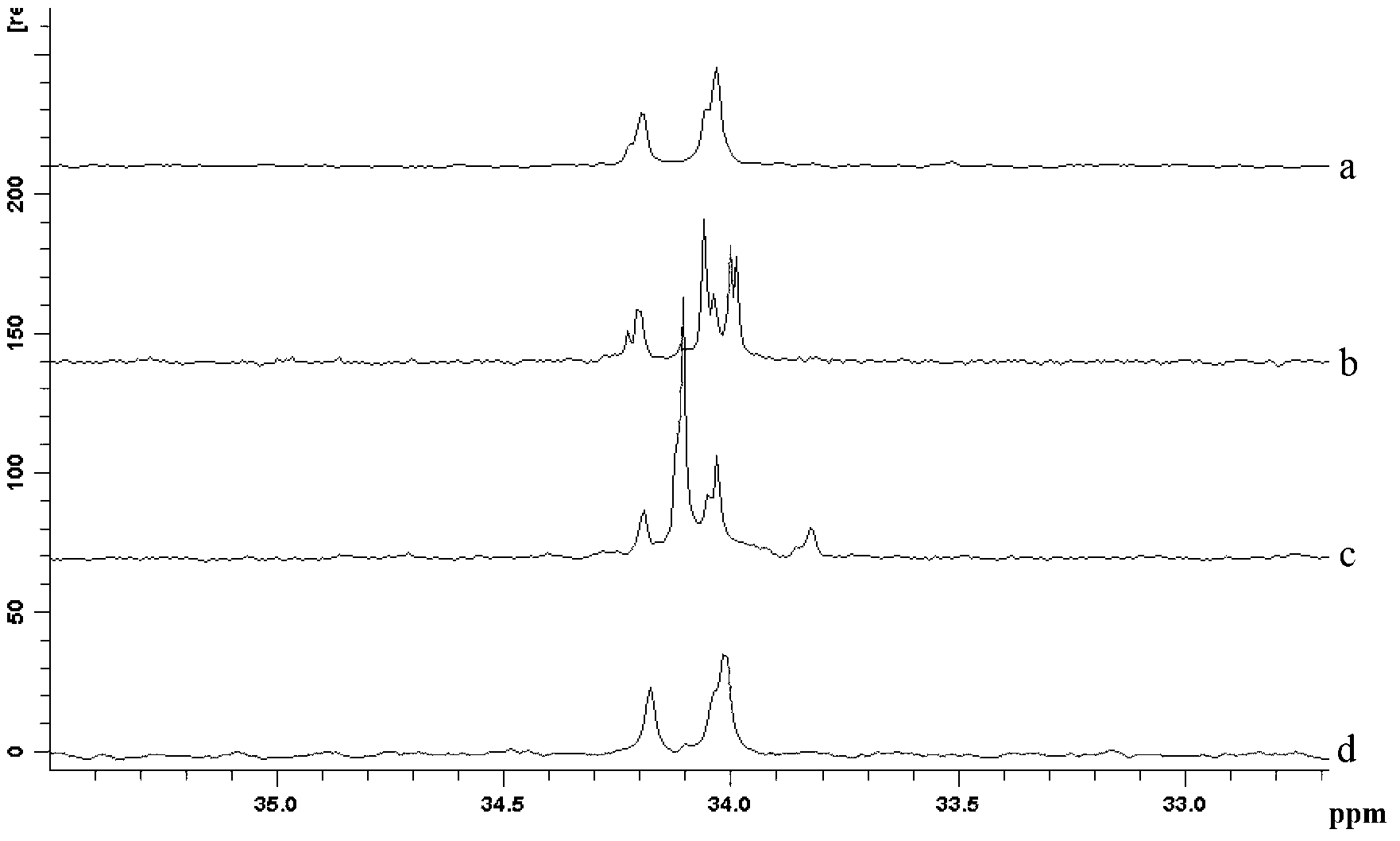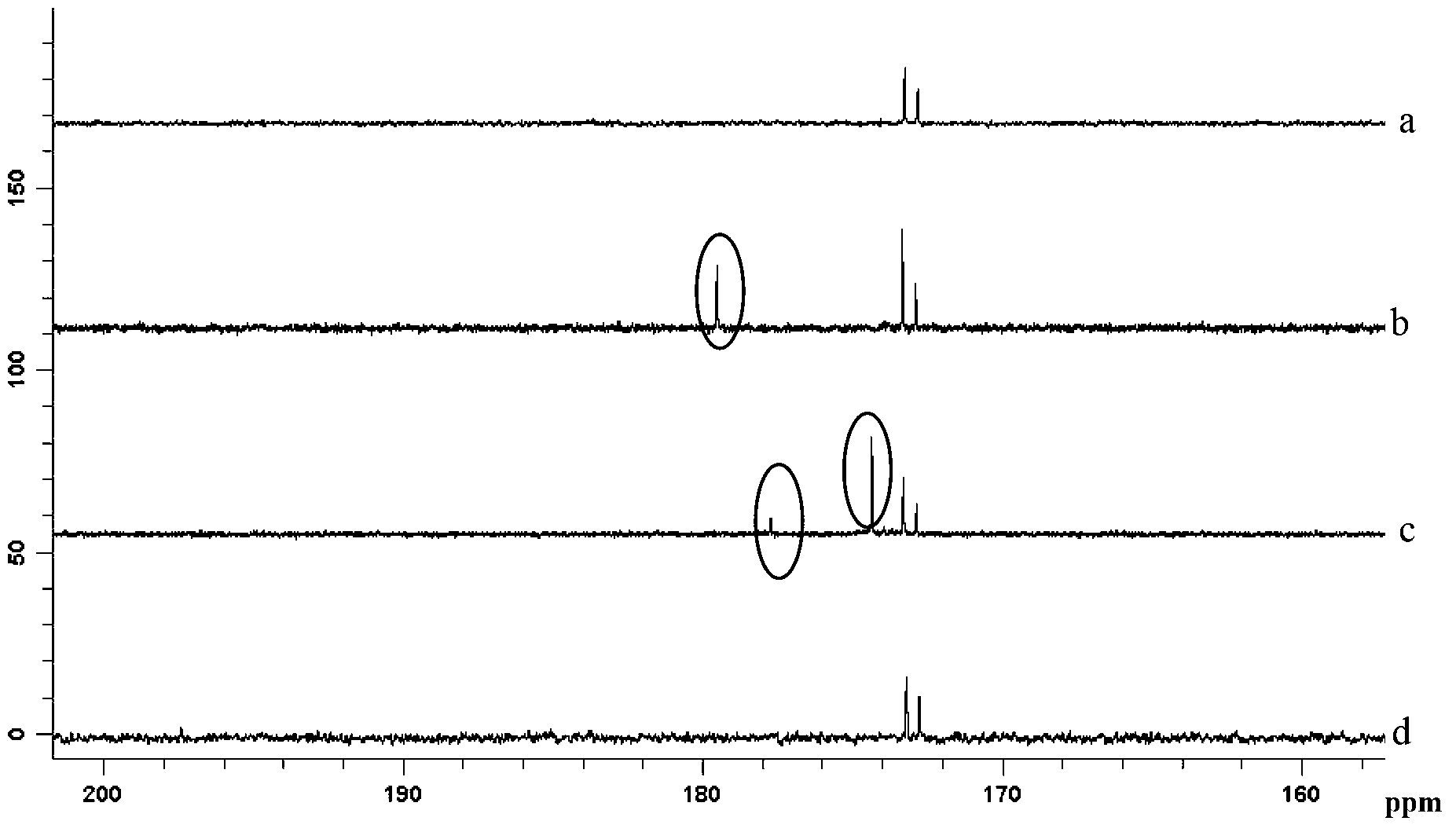Method for detecting illegal cooking oil
A detection method and technology for waste oil, which are applied in the direction of analysis using nuclear magnetic resonance, can solve problems such as inaccurate detection, and achieve the effects of high repeatability, simple operation, good repeatability and stability
- Summary
- Abstract
- Description
- Claims
- Application Information
AI Technical Summary
Problems solved by technology
Method used
Image
Examples
Embodiment 1
[0039] Measure 300 μL of peanut oil into an NMR tube, add a deuterated solvent to obtain the sample to be tested. The hydrogen spectrum was collected by a high-field NMR spectrometer such as Figure 5 and carbon spectra such as Image 6 , after obtaining the spectrum, first compare as figure 2 Characteristic fingerprint peaks in the chemical shift range of 33.0 to 35.0ppm; compare as image 3 The characteristic fingerprint peaks in the range of chemical shift 150.0 to 190.0ppm; compare as Figure 4 Characteristic fingerprint peaks in the chemical shift range from 40.0 to 80.0 ppm. Judging by the fingerprint peak is normal. At the same time, the original data can be exported, and the software developed by ourselves can be used to calculate the specific composition, saturation, relative acidity and relative oxidation of fatty acids. The results are shown in Table 1. figure 1 Give the waste oil judged by the difference of the total hydrogen number of saturated fatty acids. ...
Embodiment 2
[0043] Measure 300 μL of olive oil into an NMR tube, add a deuterated solvent, and obtain the sample to be tested. The hydrogen spectrum was collected by a high-field NMR spectrometer such as Figure 5 and carbon spectra such as Image 6 . After obtaining the spectrum, first compare as figure 2 Characteristic fingerprint peaks in the chemical shift range of 33.0 to 35.0ppm; compare as image 3The characteristic fingerprint peaks in the range of chemical shift 150.0 to 190.0ppm; compare as Figure 4 Characteristic fingerprint peaks in the chemical shift range from 40.0 to 80.0 ppm. Judging by the fingerprint peak is normal. At the same time, the original data can be exported, and the software developed by ourselves can be used to calculate the specific composition and saturation, relative acidity and relative oxidation of fatty acids. The results are shown in Table 2.
[0044] Table 2
[0045]
Embodiment 3
[0047] Measure 300 μL of soybean oil into an NMR tube, add a deuterated solvent, and obtain the sample to be tested. The hydrogen spectrum was collected by a high-field NMR spectrometer such as Figure 5 and carbon spectra such as Image 6 , after obtaining the spectrum, first compare as figure 2 Characteristic fingerprint peaks in the chemical shift range of 33.0 to 35.0ppm; compare as image 3 The characteristic fingerprint peaks in the range of chemical shift 150.0 to 190.0ppm; compare as Figure 4 Characteristic fingerprint peaks in the chemical shift range from 40.0 to 80.0 ppm. Judging by the fingerprint peak is normal. At the same time, the original data can be exported, and the software developed by ourselves can be used to calculate the specific composition, saturation, relative acidity and relative oxidation of fatty acids. The results are shown in Table 3.
[0048] table 3
[0049]
PUM
 Login to View More
Login to View More Abstract
Description
Claims
Application Information
 Login to View More
Login to View More - R&D
- Intellectual Property
- Life Sciences
- Materials
- Tech Scout
- Unparalleled Data Quality
- Higher Quality Content
- 60% Fewer Hallucinations
Browse by: Latest US Patents, China's latest patents, Technical Efficacy Thesaurus, Application Domain, Technology Topic, Popular Technical Reports.
© 2025 PatSnap. All rights reserved.Legal|Privacy policy|Modern Slavery Act Transparency Statement|Sitemap|About US| Contact US: help@patsnap.com



